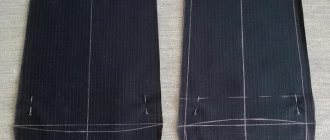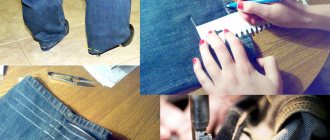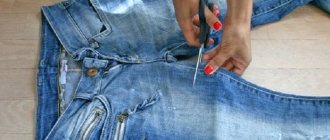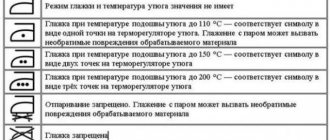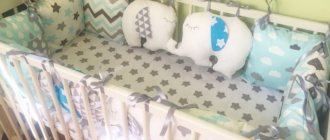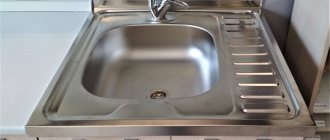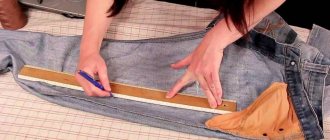Reducing the waist
There are several ways to sew trousers in the waistband: insert darts or cut off the excess with scissors along the side seams or along the step cut. The first method is good for light and medium fabrics, and it is better to adjust jeans at the seams. Reducing the sides is suitable if you are going to alter a man's trousers. There are practically no darts made on them.
Correcting the middle seam
Reducing the step cut (located at the back, in the center) is the best solution if your figure has a large difference between the waist and buttocks. The operation is simple; the only thing that can complicate things is the belt loops, which will need to be moved.
- Open the waistband stitching by 10-12 cm and step the cut to the hips or below. Open the belt loops if there are any.
- Mark a new center seam line with chalk, adding an inch on each side for the seam allowance.
- Place a line. Try it on and make changes if necessary.
- Cut the belt in half and reduce it to the new size.
- Move the belt loops to a new distance, and then sew them in the same way as the rest.
Don't cut the fabric without making sure you leave an allowance. It is better to first lay a new line, and then cut off the excess, so that there is still an opportunity to fix everything.
We correct only on the sides
The operation is similar to the method described above with the difference that now we are making adjustments only on the sides.
- Unfasten the waistband at the sides and spread the product out to the sides by 20-23 cm.
- Mark new lines, hand baste and try on.
- Sew stitches on a sewing machine.
- Reattach the waistband the same way it was finished.
Reduce with darts
You can reduce the waistband of your pants by adding darts. They are placed on both sides, at a distance of approximately 10 centimeters from the center. Darts are useful if the fastening is located on the side. This method is often used to sew in women's trousers.
- Decide where you will place the darts. Undo the belt in all these areas: you will have to rip it off almost completely, leaving only the clasp intact.
- Try it on and fold in excess fabric and pin it.
- Baste by hand and then stitch by machine.
- Iron the darts, placing them mirror-like from the center line.
- Cut the belt, remove the excess length and stitch again.
- Sew it to the waist.
How to choose leather trousers
The right model of leather trousers will become no less versatile basic bottom than classic jeans, and at the same time will add a little boldness to your looks and make your wardrobe more interesting and varied.
Find your style
Leather has remained one of the main trends for several seasons in a row, so now trousers of almost any style are available in stores, and you can choose any one.
If you want the item to create a harmonious silhouette, remember that wide and cropped flared trousers like culottes can visually reduce your height, while tight skinny pants add volume. To be on the safe side, choose straight or slightly tapered full-length models. They will successfully highlight any figure.
Give preference to mid- or high-waisted trousers. Models with a low waist look out of date, make the figure disproportionate and will simply fall off.
Evaluate the material and quality of tailoring
The skin should be tight, but not too thick and rough. Things made of thin material usually don’t fit as nicely and make every fold on the body noticeable.
It is important to remember that genuine leather stretches quite a lot. Therefore, when trying on, make sure that the trousers fit snugly. It’s also not worth going overboard and taking pants several sizes smaller, otherwise you’ll repeat the fate of Ross from the TV series “Friends” and won’t be able to take them off without outside help.
Artificial materials in most cases are not as flexible as natural ones and will retain their original shape. But just in case, study the composition on the label and read reviews of the item in online stores.
It's worth thinking about what time of year you want to wear your trousers. Faux leather will be uncomfortable in the summer, so for warm weather it is better to take trousers made of thin natural material.
Before purchasing, carefully examine the seams. If they are not strong enough, trousers, especially tight ones, can easily burst with one wrong movement. You should also make sure that the item has high-quality accessories: buttons, snaps and zippers should be reliable, firmly attached to the fabric, but at the same time unfasten without difficulty.
Experiment with colors and textures
Matte black leather trousers are a classic that will fit well into any wardrobe. This item is very easy to combine, and you can probably find it in your nearest store.
But pay attention to the noble dark green, caramel, burgundy and beige shades. Pants of these colors can also be used as a base, and they will look much more luxurious than black ones.
View this post on Instagram
Posted by EMELIE (@emitaz)
If simple paths and boring things are not for you, take a closer look at textured materials. Vinyl and python or crocodile trim will make the pants even bolder and brighter. To avoid looking too outrageous, wear them with simple and discreet things.
View this post on Instagram
Posted by Ece Tuncel (@eceetuncel)
Decor in the form of zippers, voluminous patch pockets and rhinestones most likely will not decorate the item. Leather trousers themselves are a noticeable element of the wardrobe. They don't need unnecessary details.
If you still want to choose an unusual model, buy trousers with contrasting stitching or slits on the legs.
View this post on Instagram
Posted by Filippa Hägg (@filippahagg)
Reducing the width
Sometimes it is necessary to sew the product in width - reduce the volume, narrow it or even it out. This can be done by adjusting them only on the sides or on both sides - external and internal.
Sew on the sides
One of the easiest ways: for straight legs, and cases when you don’t need to remove too much fabric. Wide leg trousers are easy to sew in.
- Open the waistband in sections 4 cm on each side of the seam on both sides.
- Unravel the side seams in areas where you need to reduce the size of the trousers.
- Sew a new stitch by hand using thread or pins. Try it on and check the fit.
- Mark a new line with chalk and remove the pins. Then step back 1 cm inward from the marked lines and draw an allowance. Trim off excess fabric.
- Stitch the item, try it on again and, if everything is in order, work on the seam allowances.
- Sew on the belt.
In addition to a simple connection, the pants can be processed in a more complex way: Moscow seam, hemmed, with edging. If performing the same processing method is beyond your capabilities, then you can either choose an easier method or contact a studio.
Sew the sides of the trousers
If you need to make major adjustments, it is better to sew the pants on both sides - along the inside seam and along the side seam. This method is often used to sew men's trousers. If you want to narrow your pant legs, this method is best.
- Spread the item on both sides. Also unravel the step cut in the groin area.
- Use chalk to mark new seam lines.
- Put the product together by hand and try it on.
- Sew the sides first, then the inside.
- Place one pant leg inside the other and connect the step cut, falling exactly into the stitch.
The main thing when remaking products is fitting. Carry it out at every stage so that the item fits like a glove. It is advisable if someone helps you, since it is quite difficult to assess the fit on your own.
Is it possible to reduce the size
If you reduce by more than two sizes, the item will have to be altered again, so it is better not to do this at home. It is possible to sew in trousers a size smaller, but to do this you will have to adjust them along the entire length and at the waist. To do this, they will have to be almost completely ripped apart. This type of work is quite labor-intensive and requires high sewing skills.
- To do this, completely unravel the product. If no changes are made to the fastener area, then it does not need to be ripped open.
- If you have a pattern, use chalk to trace it onto the old pieces. If there is no pattern, then you can reduce the trousers along the main points and draw new lines on the fabric.
- Trim off excess fabric, leaving allowances.
- Sew the item along the new outline and finish the seams.
- Refold the bottom and stitch the waistband.
Jeans is a material that is made from thick cotton. After an unsuccessful wash, it may change in...
If you are undertaking such an operation for the first time and are not sure of the result, then perhaps you should contact a studio. They'll definitely be able to sew your trousers in properly. Professional tailors will do the job carefully and ensure a fit - but in this case there will be no savings.
How to reduce waist size
Many girls face the problem that their trousers or jeans are too big in the waist or hips. Manufacturers, as a rule, sew pants for women with a rectangle body type. For this reason, other girls suffer from poor clothing sizes. There are several methods for sewing up the sides of trousers at home.
A common method is to sew along the undercuts . Often, the size of a product is reduced by ripping out some of the seams. Housewives loved this method for its simplicity. To use this method of suturing, you first need to try on the item and evaluate future changes in the item. Then the pants need to be ironed and put on again. The boundaries of excess fabric must be marked with pins. To avoid folds or distortion, you need to watch the edges of the darts - they should not rest against the side seams. The harness and belt should be cut apart and the necessary lines drawn. It is recommended to cut off excess pieces of fabric and sew the edges using a machine. The belt must be cut from the sides and the excess removed with scissors. Then you need to process its edges, sew it to the pants along the lines, and attach a harness.
Along the back seam is the easiest and fastest way to sew things up. This should be done as follows:
- after trying on, rip off the belt loops and belt, which then cut in half;
- open the stitching on the middle seam and sew to the intended distance;
- shorten the belt, process it;
- sew to the product, restore the belt loop.
Re-stitching is one of the most difficult and time-consuming methods. It is recommended only for experienced craftswomen. Altering trousers is not an easy task, but with this method you can completely update things. Master Class:
- undo the belt loop in the back of the trousers;
- separate the belt a few centimeters in two directions, open the crotch seam (by 9 cm), do the same with the middle one;
- secure the elements with pins, in the area of the waistband, retreat 2 centimeters from the middle line, draw the border of the future seam (you should get a triangle);
- machine stitch the edges, crotch seam, cut off the excess at the waistband, stitch the edges;
- sew the belt into place, carefully attach the belt loop.
How to tape your pants
Fashion is capricious and changeable.
What was fashionable yesterday, you no longer want to wear today. But what to do if the thing is still good, but not very fashionable? Here, for example, are trousers: sometimes fashionably wide, sometimes straight, or even tapered at the bottom.
If you know how to taper your trousers , you can turn wide trousers into trendy skinny ones. It will only take you a couple of hours.
We tear off the bottom hem, place a basting along the hem line and slightly smooth the fold.
We turn the trousers inside out and mark the lines along which we will narrow the trousers.
To do this, you need to decide from which place you want to narrow them. The starting point (mark 1) can be at knee level or hip level. It depends on the original style of the trousers and your desire.
I tapered my trousers from the hip.
Important: try to ensure that the transition from the old seam line to the new one is smooth.
On each side of the trouser halves along the hem line, measure 1-2 cm from the internal and external seams in the direction of decreasing the width of the trouser leg and put mark 2.
We draw new lines for the side and inner seams of the trousers, connecting marks 1 and 2 (Fig. 1).
Attention: the new seam line on the hem allowance must be symmetrical relative to the fold line, i.e. it should expand from mark 2 to the edge of the trousers (Fig. 2).
We pin and baste along new lines (Fig. 3). We grind.
We rip out the old seams.
Important: Secure the old seams where they meet the new ones.
We smooth the seams (Fig. 5), process the cuts with an overlock or zig-zag seam. We cut off the excess allowances (Fig. 4).
Processing the bottom cut.
Baste and iron the fold.
Important: When using wet heat treatment, do not forget to place strips of whatman paper so that the hem does not print on the front side (Fig. 6).
We hem the bottom with an open cut using a velvet seam.
Figure 7 shows a photo of the trousers after tapering.
Now you know how to narrow your pants. You are at the peak of fashion again!
The problem of changing pants to a size smaller can arise for various reasons. Firstly, the new thing may not fit your figure so perfectly. The non-standard figure of girls pushes them to undergo this operation in the pursuit of beauty. For example, height, fatness or thinness. Most often the length is shortened.
Secondly, the product may stretch if washed incorrectly. Most often this is non-compliance with the temperature or spin conditions. The length or width of the trouser legs is altered.
Thirdly, my favorite thing became too big after losing weight. You will have to change the width of the trouser legs, at the waist, at the hips. Fourthly, the purchase was made under the influence of a moment of weakness. I liked the model, but didn't have the right size. But upon closer examination, it was decided to sew in or alter the product.
Fifthly, following fashion trends is not always affordable for fashionistas. And you have to resort to tricks. One such change is altering existing trousers. Or just change the model of your pants. Sixth, the trousers can fit well, except in some places. For example, flares, in the hip area.
Features of working with classic trousers
To transform classic-cut pants into trendy “pipes,” you can use classic sewing methods. However, you need to know a few secrets of tailors that will help you achieve the perfect fit:
- be sure to open the crotch seam to eliminate unsightly creases when the hip line decreases in the side seams;
- at the stage of making new patterns, you need to mark the knee line (the mark will allow you to accurately determine the position of the new seams);
- for a tight fit and at the same time freedom of movement, you need to measure the volume of the knee and add 2-3 centimeters;
- The width of the bottom edge should not exceed 15-18 centimeters.
Strictly measured proportions will allow you to achieve an ideal fit and fit of trousers strictly according to the figure of the owner of a stylish item.
How to sew pants by hand
Initially, you should decide in which directions you need to sew your trousers. So, you can sew in the length of the product (shorten), the width of the trouser legs themselves, along the hips (at the waist or along the entire length), remove flares, and adjust the waist.
It is necessary to stitch evenly from the side and from the step (internal) seam.
Sometimes you can do without a pattern. This applies to small adjustments to things. For example, changing the length, inserting small darts, narrowing the bottom of the trousers. And sometimes a pattern is required. This applies to adjusting clothing around the waist. The less you change, the easier it is to change.
Preparation
First, the product is washed. For example, cotton and wool shrink the product and can fit to size.
Then the trousers are ironed. This is necessary to prevent errors and irregularities. Trying on pants. Excess fabric is marked with pins.
It is always advisable to have chalk or soap on hand for marking, a sewing ruler, scissors, pins, thread, and a sewing machine. It is better not to draw with a pen or pencil, otherwise marks will remain.
Preparatory stage
First, it is important to determine in which area the trousers need to be sewn. Possible options:
- along the entire length of the item;
- in width;
- in the waist of the product;
- along the inner seam of the trousers;
- changing the style of flares.
Minor alterations to clothing do not require a pattern. For example, when changing the length or inserting grooves, it is definitely not needed. Without a pattern, it is impossible to sew pants into a waistband, so you will have to spend a little more time.
The product must be prepared for use:
- Wash. This must be done, because the trousers may shrink a little and become the right size for the owner.
- Pet. It is necessary to avoid mistakes and the appearance of irregularities.
- Try it on. At this stage you need to mark the excess fabric using a bar of soap.
It is advisable to draw on jeans and trousers with a bar of soap, and not with chalk, a pen or a pencil. This prevents the need to wash the item again. Dry soap marks can be removed with an iron.
Wash
pat
Try it on
How to sew bell-bottom pants into straight ones
A flare is a slight extension of fabric onto items. The expansion can be smooth and large. It can start from the hip, knee, or mid-thigh.
- Initially, you try on your pants and need to twirl in front of the mirrors.
- The fit of clothes is examined from different angles.
- Excess fabric on the wrong side is marked with sewing pins or needles with knobs. It is recommended that someone do this to avoid curvature.
- We attach the needles with the point down so as not to prick.
- You can measure on both legs at once, but in the end they should be the same. Or then measure the processed one and transfer it to the second one.
- The product is carefully removed without touching the needles.
- The product is laid out on the table. The edges are aligned.
- First, all the work will be done on one trouser leg, then on the second.
- Using tailor's chalk, we mark with dashes the places marked with pins. If you choose a pen or pencil, you will have to scrub for a very long time.
- We take out the pins.
- Straighten the pant leg again.
- We draw a straight line.
- Mark a second line on the side seam 1-2 cm.
- We baste the seam along the first line.
- Try it on. Checked for measurement error, curvature, comfort.
- The thing is removed. Adjustments are made if necessary.
- Trying it on again.
- Excess fabric is trimmed.
- Ironed.
- The product is turned inside out if it was previously done on the front side.
- Levels out.
- The ends are processed separately or together. Preferably using a machine using a zigzag or machine foot.
- The product is stitched on a sewing machine. Ready.
What to do with bell-bottoms?
The bell-bottom style was very popular just a few years ago, but today these pants can look quite ridiculous. Therefore, girls should know how to turn out-of-fashion trousers into a stylish and fashionable wardrobe item.
First you need to try on the item with the wrong side out and pin up all the excess parts with pins. All manipulations are first done on one trouser leg . Then they draw the lines of the new pants with a piece of old soap. The legs are then joined together and the lines are transferred to the second leg.
Next comes hand stitching with a thread of a contrasting color and a new fitting. If everything fits perfectly, you can sew the product on a machine. If you are not satisfied with the result, you will have to remove the bastings and perform all the manipulations all over again. Finally, new seams are sewn on a sewing machine, the edges are processed with a zigzag.
How to tape your trousers at home
There is nothing difficult in creating such beauty. Open the bottom edge (hem). Iron the product. Try on the pants from the wrong side. Spin around the mirror. Mentally estimate how much it needs to be narrowed.
Adjustment on one side is made subject to slight narrowing. Then it looks more practical (internal or external). Is there any decor?
Mark excess material on the material with pins. You have to be careful here. This may affect stretch fabric. The fabric will stretch a little and the stitching will be crooked. If the fabric is non-stretchy, your legs should fit comfortably into the pant leg. The main thing is not to overdo it.
- Remove carefully and spread on the table.
- Align. Draw a line with chalk along the marked areas. Draw a 2nd line for the seam.
- Baste with threads along 1 line.
- Try it on again and check the comfort.
- Adjust as necessary.
- Trim off excess fabric.
- Seal the edges.
- Machine sew trousers.
Adjustments on both sides are made under the condition of large narrowing. The same actions are performed, only on both sides at an equal distance. Otherwise it will be crooked. Finish hem and iron.
How to properly sew in the sides of trousers with your own hands
If the trousers are too large due to lack of volume in the hip area, then suturing can be done along the outer seam.
- Turn the product inside out.
- Try it on. Squat, walk around.
- The places to reduce how much are indicated with pins. Everything is distributed equally to avoid curvature.
- Draw a straight line with chalk.
- Manually sweep the marked areas.
- Turn it onto your face and try it on.
- Rip out the factory seam.
- Sew along the seam you have marked. For the entire length of the trouser leg, so that there are no distortions.
- Cut off the excess pop of the material and process the edges.
- Sew on the waistband and bottom edge of the trouser leg.
- Don't forget about the 2nd leg. Both should be the same length.
Sometimes the external seams are not touched due to decoration or other reasons. And they stitch along the inside line. This stitch is used for problems with the waist.
Instructions:
- The product is turned inside out.
- The excess is tried on and noted.
- The product is removed and placed on the table.
- The belt is separated. Cut in half from the back.
- Using a thread and a needle, a new seam is applied to the 2 halves of the item.
- The excess is trimmed and the edges are processed.
- It is being stitched.
- The belt is sewn on.
There are times when it is necessary to use internal and external seams. This applies to sewing up a couple of sizes, trousers with flares from the hip. Manipulations are performed as when sewing a side seam, only it is distributed over all seams.
How to make skinny jeans
If wide jeans are made from soft, stretchy fabric, they can be converted into skinny jeans - they sit tightly on the hips and calves, tapering downward. The bottom of the pants is ripped off and hemmed last, after fitting; in most cases, they need to be shortened. Excess fabric must be pinned off in such a way that waves, creases or distortions do not form. It is a mistake to think that you can only sew jeans on the side of the seam where there is no finishing stitch. For comfortable free movement, you need to leave 2-3 cm at the following points:
- ankle;
- the middle part of the leg between the knee and ankle.
After this, the upper point from which the narrowing begins is determined, and all 3 marks are connected under the ruler and swept away.
For skinnies, leave an allowance of 1.5 cm. Excess fabric is cut off and the parts are sewn down. Then the seam allowances are processed by folding them together and ironed onto the back halves.
The parts of jeans at the factory are connected with a backstitch, which is difficult to reproduce at home without skills, so to ensure that the seam is the same along the entire length, the vertical and finishing stitches are completely ripped out. On the inside of the leg, the details do not need to be stitched with contrasting thread. And to decorate the exterior ones, choose threads that match the color and a thick needle (No. 100-110). To ensure that the stitching does not differ from the factory one, a thread folded in half is threaded into the needle.
When sewing seams from several layers of fabric (for example, in places of side seams with a hem), it is recommended not to rush, turn the wheel manually and pull the fabric away from you.
How to shorten pants
You need to try on the item. Fold the excess fabric and secure the length with needles. It is advisable to carry out this to a third party. This way there will be no curvature or length errors on the product. If this is a female model, then you need to take into account the heel. Also, the length depends on the model of the pants. If they taper towards the bottom, the edges should be just above the heel.
Place the product on the table and spread it out. Draw straight lines using chalk along the marks. The first is the desired length, the second with a hem. It will be 1-2 cm for women, 4-5 for men.
It is necessary to go through with a needle and thread to secure the desired result. Try it on again. Spin around the mirror. Then remove. If necessary, make adjustments.
Place the product on the table. Trim off excess material. Finish the edges. Sew on a machine.
It is not always necessary to cut off excess fabric if the excess fabric is small. You can simply hide them in the hem. Or use double-sided sewing tape at the hem. But after each wash you will have to re-attach it.
It is often recommended to sew on the braid. It will prevent the edges from fraying. The shade of the braid is selected to match the tone of the product.
It is better to sew it on a product that has never been worn. But the edges have already been treated to prevent fraying. The middle of the braid should run along the final length of the product. It is necessary to baste there.
On the inner side seam we bend the free end so that the beginning is closed. Fold the braid in half. It should remain inside and stick out from below by a couple of mm. We stitch on a machine. We process the hem of the product.
How to sew sweatpants
With this action, the material (knitwear), edge processing (straight, with elastic, with ties), and the tailoring itself are taken into account. These can be with an oriental motif, tight, straight pants. In a tight model, almost the entire model is most often altered. In the eastern ones, the side and crotch seams are altered.
So, the pants can be too wide in the elastic at the waist, too big in the leg, and in length. If the sweatpants are too big at the hips, you will have to sew them in at the side seams. Reduces material in equal proportions along all seams. Sometimes the middle seam is also connected when adjusting the seat height.
- Try it on.
- Mark excess material with pins. Remove the product.
- Turn inside out. Gently straighten it on the table.
- Draw a line. Leave to process the edges.
- Baste along this line.
- Try it on and compare the difference. Take off.
- Open the waistband and the bottom edge of the trouser leg.
- Open the edges of the side seams, the step seam, and the isch seam. Especially if the model should fit the figure. Most often, you can only sutured on the sides.
- It is stitched by machine.
- The edges are processed.
Excess material on the belt is trimmed. The edges on it are processed and sewn back. If there is an elastic band, then it looks according to the situation (how it fits on the figure and what kind of elastic). If there is a lot of material, it is better to trim it. Everything should look aesthetically pleasing.
If the problem is the length, then it is shortened. The elastic bands are altered onto the shortened product, taking into account their height.
How to sew wide-leg trousers along the entire length
Most often this concerns suturing on the sides, affecting the waist. This method is possible when suturing 2 sizes. The side, step, and ischial seams are altered. The material is removed evenly. The belt is also affected. This is described above.
If you need to alter an item to a larger size, you will have to redraw everything, build a sketch, transfer it to fabric and cut it, grind it and then sew it together.
Any thing can be sutured, but you need to clearly understand whether anyone can handle it. Most often, complex adjustments are required. And there is a risk of messing up. If you are not sure, you should take it to the studio. It would be a shame to ruin a good thing. It is worth considering one more nuance. Not all trouser models can be sewn in due to the peculiarities of tailoring.
How to alter jeans without need
There are many simplified instructions on the Internet that advise you to quickly make wide jeans narrow. An illustrative example:
It is worth warning that this method does not work. By removing excess fabric from only one side, you are guaranteed to end up with twisted jeans. In addition, if your trousers are generally too big, you need to narrow them in several places, and according to certain rules. If the difference is more than 2 sizes, the trousers are completely recut. It is better to entrust major alterations to specialists.
So, it’s not difficult to turn wide jeans into skinny ones if you only need to redo the bottom part. To do this, the width is reduced at both seams. On average, the work takes from 30 minutes to 2 hours. Using step-by-step instructions, you will get exactly the result you expected!
